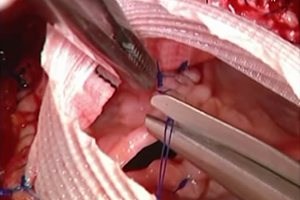Bicuspid aortic valve repair adapted to aortic phenotype
Abstract
The bicuspid aortic valve (BAV) is the most common congenital cardiovascular anomaly and may present with differing phenotypes including almost constant annular dilation. We have developed a standardized approach to BAV repair with a systematic adjunct of aortic annuloplasty according to the three phenotypes of the proximal aorta, which include a dilated aortic root, dilated ascending aorta and normal root and ascending aorta. In our cohort of 191 patients, freedom from AV-related re-intervention was 98% for remodeling with annuloplasty (n=100) and 100% for tubular aortic replacement with annuloplasty (n=31) at 8 years. In an isolated aortic insufficiency (AI) group, freedom from AV-related re-intervention varied from 72.4% with a single subvalvular annuloplasty ring (n=31) compared to 100% at 6 years when a double sub- and supra-valvular (STJ) annuloplasty ring was performed (n=29). Restoration of the annulus: sinotubular junction (STJ) ratio is a key factor to ensure longevity of the bicuspid valve repair and freedom from re-intervention.
Cover






